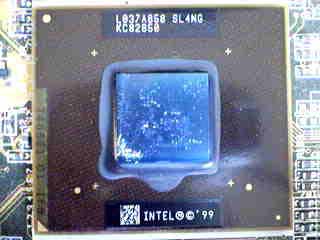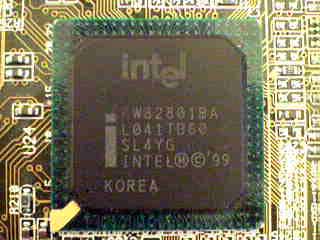ASUS P4T i850 Pentium 4 ATX Motherboard
by Mike Andrawes on May 9, 2001 2:56 PM EST- Posted in
- Motherboards
New Chipset, Old Brother
As we have mentioned in our initial Pentium 4 review, the i850 chipset is actually very similar to the i840 chipset with some changes. The i850 chipset supports the new Pentium 4 AGTL+ bus and its quad pumped 100MHz FSB, effectively running at 400MHz.
Unfortunately, the 82850 MCH only supports 1.5V signaling, so the AGP Pro slot on the P4T is keyed for 1.5V AGP devices only. For the most part, this will only exclude many AGP 2X cards and a few AGP 4X cards, the most notable of which is the 3dfx Voodoo5 line.

82850 MCH
There are a total of four RIMM slots on the PT4, and that will be the case for all current Pentium 4 motherboards. You will have to follow the instructions outlined in the manual to insert RIMMs and CRIMMs in the correct configurations. Each RIMM slot can accept 64MB, 128MB, or 256MB modules, meaning that the maximum support memory configuration is 1GB of RDRAM.
Like the i815E chipset, the i850 chipset uses the 82801BA I/O Controller Hub 2 (ICH2) for all PCI devices and I/O controls. The ICH2 supports two Ultra ATA 100 channels and two USB root hubs for a total of four USB ports. Two of the four ports are located on the I/O panel at the back of the board, and the connector for the third and fourth ports is located on the left side of the board. ASUS has included the necessary bracket, which contains two USB ports and all the cables, so you can take advantage of the two extra ports right out of the box.

82801BA ICH2
The 5/1/0/0 (PCI/AGP/CNR/ISA) expansion slot configuration is pretty much the standard these days. The five PCI slots should be enough for most users, although we have seen some boards offer six PCI slots for more flexibility. The most interesting thing is that ASUS, being the largest OEM supplier in the world, did not include a CNR slot as the default setup, which could help OEM builders provide cheap network solutions. Their decision was probably due to the fact that CNR devices are not widely available on the open market at all. Nevertheless, ASUS still states that there is an option to take advantage of the ICH2’s integrated LAN controller, and the Ethernet RJ-45 port would be placed on top of the two USB ports within the I/O panel.
Yet another surprising decision by ASUS is the omission of an on-board audio setup, which is another thing most OEM builders take advantage of to help reduce costs.
Our theory on all this is that ASUS has realized that the majority of hardware enthusiasts building systems for themselves do not take advantage of host-based AC’97 audio, preferring to use their own sound cards instead. The same goes with CNR. As such, ASUS has decided to make these options available to OEM’s to keep them happy, while at the same time not passing on their costs to the enthusiasts that won’t use them anyway. Kudos to ASUS for such a wise decision.

Silkscreen for optional AC’97 CODEC










0 Comments
View All Comments